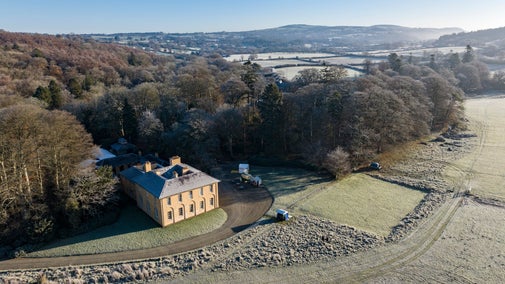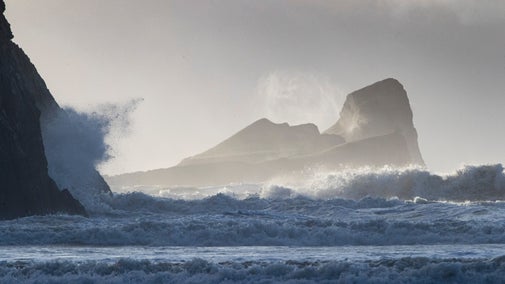
Discover more in Wales
A Celtic land with an industrial past steeped in myth, legend, poetry and song. Croeso i Gymru.

Take a journey into the past and find out more about some of the people and places that have shaped the Llŷn peninsula. Discover what buildings to visit and learn about this distinctive landscape.
Follow a path through time and discover the last stopping point for pilgrims before crossing to Bardsey Island. Follow in their footsteps and visit one of the most beautiful places in Wales. Known as the 'Cathedral of Llŷn', the church of St Hywyn is in a striking location at the edge of the beach and well worth a visit.
Discover one of the richest areas of archaeological remains on Llŷn. The Tan y Muriau burial chamber and the ‘double ringwork’ hilltop enclosures provide a glimpse into how people lived on the peninsula thousands of years ago.
The axe factory at Mynydd Rhiw was discovered in the 1950s during gorse burning. It is reasonable to assume that the site dates to between the 5th and 3rd millennium BC (the Neolithic period).
It consists of several round hollows where rocks were excavated and flaked to produce various tools, such as axes and scrapers. These were traded widely over a very long period during the Neolithic and early Bronze ages.
This helps to reveal a picture of life on the flanks of Mynydd Rhiw at the end of the Stone Age. The remains show how Neolithic people strived to quarry a type of rock especially suitable for the manufacture of stone axes, and other tools of great importance to their way of life.
Excavations near Rhiw led to the discovery of a circular ‘double ringwork’ enclosure at Meillionydd. This is a type of hilltop enclosure that is found mostly on the Llŷn peninsula. It consists of two circular banks of earth and stone with a handful of internal roundhouses. The enclosures are likely to have been the permanent homes of several family groups. They would have also been a site for larger communal gatherings
The double ringwork enclosures offer a unique and as yet largely untapped resource for studying the origins of settlement in the Late Bronze Age and Early Iron Age (c. 1000–600BC).
Excavations carried out by the Bangor University project team demonstrated that Meillionydd was occupied for a relatively long period of time. The practice of occupying this monumental enclosure over a long period and the rebuilding of roundhouses on the same spot implies a desire to maintain an ongoing link with the past – creating a special sense of place and history on the site.

This quaint church nestled in a small valley was founded in the sixth century, originally being a place of respite and solitude for Beuno, a tireless missionary. It was later a hospice for pilgrims travelling to Bardsey. Artefacts include a 12th-century font and the remains of a medieval wall painting.
For centuries, this small village has been an important link between the people of Llŷn and the sea. Famous for its herring fishing, this place connected the peninsula with the rest of the world through its imports and exports.
From the Iron Age fort on the headland, to the grand idea of turning the harbour into the main port en route from London to Dublin at the turn of the 18th century, to the prolific shipbuilding and fishing industries which flourished during the 19th century, many signs of the area’s interesting past can still be seen today.

Much of the landscape at the tip of the Llŷn Peninsula was under arable cultivation during the Middle Ages, and some patterns remain visible today at Mynydd Gwyddal and Pistyll.
The traditional field boundaries - stone walls and cloddiau (earth banks) are a prominent feature and date back several centuries. They are an important habitat for wildlife.
Most traditional boundaries continue to serve the purpose for which they were originally intended – to identify divisions between properties and to protect crops and animals. See if you can spot the narrow strips of fields that feature wider corners at one end where the plough would have turned around.
The boundaries also serve as important wildlife corridors, offering shelter and protection for species unable to survive in open ground. Often, boundaries will carry both historic and wildlife interest, a testament to constructions that may have been in existence for centuries. Today, we carefully manage the cloddiau to preserve this traditional characteristic.

A Celtic land with an industrial past steeped in myth, legend, poetry and song. Croeso i Gymru.
Discover the best places in Llŷn to go birdwatching, explore wetland wildlife or catch sight of your favourite coastal creatures, from seal spotting to dolphin encounters.

Learn more about what to see and do on the Llŷn Peninsula in North Wales, from rock-pooling at Porthor to exploring culture and history at Porth y Swnt.

Discover more about the ecomuseum on the Llŷn Peninsula. Operating in partnership with seven of Llyn Peninsula’s heritage organisations, it aims to increase cultural tourism.

Come in and explore, learn, reflect and enjoy the natural environment.

Step into a medieval fortress with dungeons at Chirk or visit the home of the Welsh princes at Powis Castle. Discover some of the finest and most famous castles in Wales.

Explore magnificent Welsh mansions and their collections, from ancestral homes to buildings designed by renowned architects. Discover the history and tales from bygone days, in breath-taking settings across Wales.

Explore 157 miles of Welsh coastline protected by the National Trust, from long golden beaches to rugged clifftops.

Explore dramatic and beautiful valleys, ancient woodlands and river walks or have an adventure through the wild Welsh mountains and visit some of the country’s most iconic peaks.
